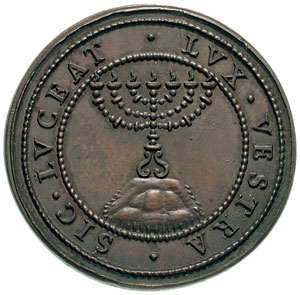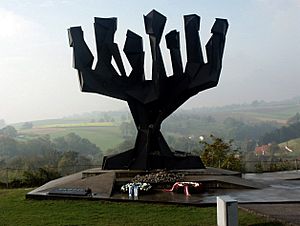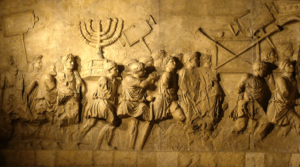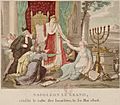Menorah (Temple) facts for kids
The menorah was an ancient lamp used by the Israelites long ago. It traveled with them through the desert and later sat in their special Temple. This lamp had seven branches: a center branch with three branches on each side. It was made of pure gold. Olive oil was used to light its flames.
God told Moses to build the menorah while the Israelites were in the desert. The menorah is linked to amazing miracles, like the miracle of Hanukkah. During the First Jewish–Roman War, the Romans destroyed the Temple. They took its treasures, including the menorah, to Rome. They showed it off during a big celebration of their victory.
Today, the menorah is a symbol on the coat of arms of the country of Israel. Many Jewish places of worship have copies of the menorah. A special nine-branch menorah is used during the holiday of Hanukkah.
Contents
What Was the Menorah Used For?
The menorah's lamps were lit every day. They used fresh, special olive oil. The lamps burned from evening until morning, as described in the Bible (Exodus 27:21).
A historian named Flavius Josephus said that three of the seven lamps could also burn during the day. However, some Jewish writings (like the Talmud) say that only the center lamp stayed lit all day. This center lamp, called the ner hama'aravi (Western lamp), was a sign that God's presence was with Israel. This special burning stopped about 40 years before the Temple was destroyed.
The Menorah's Journey Through History
The first menorah was made for the Tabernacle, a portable worship place. The Bible says it was there until the Israelites crossed the Jordan River. When the Tabernacle was set up in Shiloh, the menorah was likely there too. Later, when King Solomon built the first permanent Temple, the Bible mentions he made ten lampstands. These were later taken to Babylon by invading armies.
After the Jewish people returned from Babylon and rebuilt the Temple, the Bible only mentions "vessels" being returned, not the original menorah. Since the Temple was dark inside, some kind of light must have been used.
The Book of Maccabees tells us that Antiochus Epiphanes took the lampstands when he attacked and robbed the Temple. New holy vessels, possibly new lampstands, were made later. The Bible does not say what happened to the original menorah after this.
The menorah from the Second Temple was taken to Rome after the Roman army conquered Jerusalem in 70 AD. This happened during the First Jewish–Roman War. The historian Josephus wrote that it was carried in a victory parade for the Roman leaders Vespasian and Titus. You can still see a carving on the Arch of Titus in Rome that shows Roman soldiers carrying the seven-branched menorah.
For many years, the Menorah was displayed in the Temple of Peace in Rome as a war trophy. This temple was built with treasures taken from Jerusalem. The menorah was still there when the city was attacked by the Vandals in 455 AD. What happened to it after that is a mystery. Some say it was melted down or destroyed in a fire. Others believe it was taken to Carthage, then to Constantinople, or even sank in a shipwreck. A popular rumor is that the Vatican has kept it hidden for centuries.
Most likely, the Vandals stole the menorah when they attacked Rome in 455 CE. They probably took it to their capital, Carthage. The Byzantine army might have taken it in 533 CE and brought it to Constantinople. One historian, Procopius, said it was carried through the streets of Constantinople in a victory parade. He also said it was later sent back to Jerusalem, but there is no record of it there. It might have been destroyed when Jerusalem was attacked by the Persians in 614 CE.
What Does the Menorah Symbolize?
In Judaism
The menorah stands for the idea of spreading light and knowledge to everyone. Jewish teachings say that the menorah symbolizes wisdom. For example, one teaching says, "He who desires to become wise should incline to the south [when praying]. The symbol [to remember this] is that… the Menorah was on the southern side [of the Temple]."
The seven lamps represent different parts of human knowledge. The six outer lamps lean towards the central lamp, which stands for the light of God. This shows that all human knowledge is guided by God. The menorah also symbolizes the creation of the world in seven days, with the center light representing the Sabbath (day of rest).
In Christianity

The New Testament book of Revelation talks about seven golden lampstands. These lampstands represent seven early Christian churches in Asia. A figure "like a Son of Man" is shown among them.
Some early Christian thinkers believed the seven lamps of the menorah stood for the seven classical planets: the Moon, Mercury, Venus, the Sun, Mars, Jupiter, and Saturn.
It is also said to symbolize the burning bush that Moses saw on Mount Horeb (Exodus 3).
The Hanukkah Menorah
The Menorah is also a very important symbol for the Jewish holiday of Hanukkah. According to Jewish tradition, after the Seleucid army damaged the Jewish Temple in Jerusalem, there was only enough special olive oil left to light the eternal flame for one day. But a miracle happened: the oil burned for eight days! This gave them enough time to make new pure oil.
Jewish law says it's not allowed to use a seven-lamp menorah outside of the Temple. So, the Hanukkah menorah has eight main branches, plus a ninth lamp that is set apart. This ninth lamp is called the shamash (servant) light. It is used to light the other eight candles. This type of menorah is called a hanukiah in Modern Hebrew.
Modern Jewish Use of the Menorah

In Synagogues, there is a lamp or light that is always lit in front of the Ark, where the Torah scroll is kept. This lamp is called the ner tamid (eternal light). It represents the continually lit lamp of the menorah that was used in the ancient Temple.
Many synagogues also display a Menorah or an artistic picture of one.
A menorah is featured on the coat of arms of the State of Israel. This design is based on the menorah shown on the Arch of Titus.
Sometimes, when people are learning the Hebrew language, they use a chart shaped like the seven-lamp menorah. This helps students remember how Hebrew verbs work.
The Temple Institute's Menorah
The Temple Institute has made a life-sized menorah. It was designed by a goldsmith named Chaim Odem. This menorah is meant to be used in a future Third Temple. It is made from about 45 kilograms (100 pounds) of pure 24-karat gold. It was hammered out of a single block of solid gold. Its decorations are based on the menorah shown on the Arch of Titus and old religious texts.
The Menorah in Other Cultures
The kinara is a seven-candle holder used in the African American festival of Kwanzaa. One candle is lit each day of the week-long celebration. This is similar to how the Hanukiah is used during Hanukkah.
In the Orthodox Church, the menorah is still used. It always stands on or behind the altar in the church's sanctuary. While candles can be used, the traditional way is to use olive oil in the seven-lamp stand. Usually, all seven lamps are lit for services. Sometimes, only the three middle lamps are lit for smaller services. If a church doesn't have a special sanctuary lamp, the center lamp of the menorah might stay lit as an eternal flame.
The Menorah has also become a symbol for the Iglesia ni Cristo church since the 20th century.
In Taoism, there is a seven-lamp oil lamp called the qi xing deng (Seven-Star Lamp). It represents the seven stars of the Northern Dipper. This lampstand is required in all Taoist temples and is never supposed to go out. During a special festival, a lamp with nine connected lamps might also be lit. This honors the Northern Dipper and two other stars. Lighting these lamps is believed to help forgive sins and make one's life longer.
The Menorah in Popular Culture
The menorah is an important part of the 2013 thriller novel The Sword of Moses by Dominic Selwood. It is also featured in the archaeology novels Crusader Gold by David Gibbins and The Last Secret of the Temple by Paul Sussman. A menorah can be seen in the movie X-Men: First Class. In the film, Charles Xavier reads Erik Lehnsherr's mind as he remembers his mother.
Gallery
-
An ancient stone tablet from a synagogue in Peki'in, Israel, showing a menorah.
-
The Jewish Legion cap badge, with a menorah and the Hebrew word Kadima (forward).
-
The Coat of Arms of Israel shows a menorah surrounded by olive branches and the word "ישראל" (Israel).
-
A painting showing the Menorah being taken as the Holy Temple in Jerusalem was destroyed by the Roman army in 70 CE.
-
The Knesset Menorah outside the Knesset (Israeli Parliament).
-
In this 1806 French print, a woman with a Menorah represents Jewish people being freed by Napoleon Bonaparte.
-
A Kippa (Jewish skullcap) and Menorah from the Harry S Truman collection.
-
The Menorah presented to Tsar Boris III from the Bulgarian Jewish community.
-
The Iglesia ni Cristo flag, where the seven-branched candelabrum or menorah represents the church.
Images for kids
-
A painting by Karl Bryullov (1833-1836) showing Genseric sacking Rome, with the menorah being carried away by the Vandals.
-
A 19th-century Hanukkah menorah from Austria-Hungary, displayed at the Musée d'Art et d'Histoire du Judaïsme.
-
A drawing from a prayer book, dated 1738, showing the lighting of the Menorah. From the collections of the National Library of Israel.
-
A sketch of the menorah by Fray Juan Ricci (1600–1681), based on the description in Exodus.
See also
 In Spanish: Menorá para niños
In Spanish: Menorá para niños























